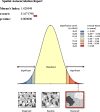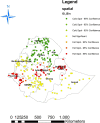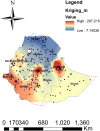Spatial variations and multilevel mixed effect analysis on determinants factors of modern contraceptive utilization among reproductive age women in Ethiopia; proven by Ethiopian mini demographic health survey 2019
- PMID: 36814235
- PMCID: PMC9948416
- DOI: 10.1186/s12905-022-02030-3
Spatial variations and multilevel mixed effect analysis on determinants factors of modern contraceptive utilization among reproductive age women in Ethiopia; proven by Ethiopian mini demographic health survey 2019
Abstract
Introduction: Globally, in 2019, there are 1.9 billion women of reproductive age (15-49), of which 1.1 billion have a need for family planning. Of these, 842 million use contraceptives, and 270 million still have an unmet need for contraception. Ethiopia is a low-income country with inadequate access to family planning (FP), especially in the developing regions. The Ethiopian government was striving to increase the number of health facility in order to provide quality maternal care and services. Increasing the modern contraceptive prevalence rate is one of the goals of the government to reduce maternal and child mortality and morbidity.
Methods: Secondary data analysis was conducted using data from mini-EDHS of 2019 demographic and health Survey datasets. The study comprised a total of 8885 reproductive-age women. Spatial variations and multilevel mixed effect analysis on determinants factors of modern contraceptive use among reproductive age women in Ethiopia; evidenced by mini-EDHS 2019. Finally, the percentage and odd ratio, its 95% confidence intervals, and the result of spatial analysis were reported.
Result: This study includes a total weighted sample of 8885 reproductive-age women from the 2019 mini-Ethiopian demographic and health survey. The prevalence of modern contraceptive use was 25.5% in Ethiopia. living in urban area [AOR = 2.13; 95% CI = (1.75, 2.61); P = 0.000], being married [AOR = 1.42; 95% CI = (1.19, 1.70); P = 0.000] were found positively associated with contraceptive use. In contrast to this, attending primary education [AOR = 0.91; 95% CI = (0.74, 1.12); P = 0.000]., being Muslim [AOR = 0.25; 95% CI = (0.22, 0.29); P = 0.000], being poorest [AOR = 0.54; 95% CI = (0.45, 0.66); P = 0.000] were found negatively associated with contraceptive use.
Conclusion: In this study Individual and community level factors were associated with modern contraceptive use and also there were spatial variations in modern contraceptive use across the region among reproductive-age women. Empowering women to have better educational status, improving the wealth index, promoting marriage, creating awareness among rural residences women and promoting education about modern contraceptives through religiously acceptable persons, and promoting modern contraceptive use in developing regions were the key factors to improve modern contraceptive use among reproductive age women in Ethiopia.
Keywords: Ethiopia; Modern contraceptive use; Multilevel; Spatial.
© 2023. The Author(s).
Conflict of interest statement
In relation to the research, authorship, and publication of this work, the author (G.M.) disclosed no possible conflicts of interest.
Figures




Similar articles
-
Spatial variations and determinants of modern contraceptive utilization among sexually active rural women in Ethiopia using mini EDHS 2019 data: spatial and multilevel analysis.BMC Public Health. 2025 May 10;25(1):1738. doi: 10.1186/s12889-025-22888-w. BMC Public Health. 2025. PMID: 40349024 Free PMC article.
-
Individual and community level factors associated with modern contraceptive utilization among married women in the emerging region of Ethiopia: a multilevel mixed effects analysis of the 2019 Ethiopia Mini-Demographic and health survey.BMC Womens Health. 2023 Dec 7;23(1):652. doi: 10.1186/s12905-023-02822-1. BMC Womens Health. 2023. PMID: 38062400 Free PMC article.
-
Geographic variation and associated factors of long-acting contraceptive use among reproductive-age women in Ethiopia: a multi-level and spatial analysis of Ethiopian Demographic and Health Survey 2016 data.Reprod Health. 2021 Jun 10;18(1):122. doi: 10.1186/s12978-021-01171-2. Reprod Health. 2021. PMID: 34112194 Free PMC article.
-
Utilization of modern contraception and determinants among HIV positive women in Ethiopia: a systematic review and meta-analysis.BMC Womens Health. 2024 Nov 20;24(1):616. doi: 10.1186/s12905-024-03454-9. BMC Womens Health. 2024. PMID: 39567937 Free PMC article.
-
Trends and Determinants of Non-Utilization of Modern Contraception in Ekiti State, Nigeria: A Ten-Year Review.J Mother Child. 2023 Aug 7;27(1):42-51. doi: 10.34763/jmotherandchild.20232701.d-22-00067. eCollection 2023 Jun 1. J Mother Child. 2023. PMID: 37545135 Free PMC article. Review.
Cited by
-
Modern contraceptive utilization and associated factors among younger and older married youth women in Ethiopia: Evidence from Ethiopia Mini Demographic and Health Survey 2019.PLoS One. 2024 May 28;19(5):e0300151. doi: 10.1371/journal.pone.0300151. eCollection 2024. PLoS One. 2024. PMID: 38805520 Free PMC article.
-
Factors associated with modern contraceptive utilization among reproductive age women in Kenya; evidenced by the 2022 Kenyan demographic and health survey.Contracept Reprod Med. 2024 Mar 15;9(1):10. doi: 10.1186/s40834-024-00271-1. Contracept Reprod Med. 2024. PMID: 38491382 Free PMC article.
-
Spatial disparities and determinants of modern contraceptive use among reproductive age women in Ethiopia: application of multilevel spatial analysis.Front Glob Womens Health. 2025 Apr 23;6:1505789. doi: 10.3389/fgwh.2025.1505789. eCollection 2025. Front Glob Womens Health. 2025. PMID: 40337010 Free PMC article.
-
Determinants of the use of modern contraceptives among women of reproductive age group in Ethiopia: A multi-level mixed effects analysis.PLoS One. 2024 Jul 5;19(7):e0306635. doi: 10.1371/journal.pone.0306635. eCollection 2024. PLoS One. 2024. PMID: 38968272 Free PMC article.
-
Spatial variations and determinants of modern contraceptive utilization among sexually active rural women in Ethiopia using mini EDHS 2019 data: spatial and multilevel analysis.BMC Public Health. 2025 May 10;25(1):1738. doi: 10.1186/s12889-025-22888-w. BMC Public Health. 2025. PMID: 40349024 Free PMC article.
References
-
- Ricci SS. Susan_Scott_Ricci_Essentials_of_Maternity_Newborn_and_Women_s_Health ;fourth edition.
-
- UNDESA. World Family Planning Highlights. Econ Soc Aff. 2017;2017:1–43.
MeSH terms
Substances
LinkOut - more resources
Full Text Sources

